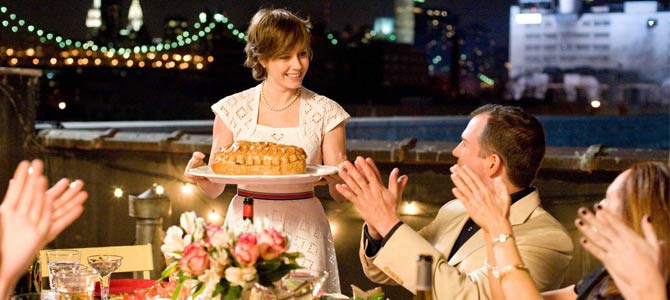Next story: The Stoning of Soraya M.
Julie & Julia
by George Sax

Fine dining and some fast food
The only thing I ever tried to learn how to do from Julia Child’s television lessons was to make a French omelette. Despite my intense focus and note-taking, I failed and still can’t do it. (I think it’s a matter of bad hand-eye coordination, the same cause for my effete tennis forehand.)
I don’t own any of Child’s very successful instruction books, but millions of others do, and millions avidly followed her several series of PBS television shows. Nora Ephron’s new movie, Julie and Julia, is really about the origins of Child’s status as an epicurean icon, even though it attempts to tell two loosely linked stories. It’s based on Child’s posthumously published book, (she died in 2004 at age 94) My Life in France, and Julie Powell’s 2003 blog-based memoir of the same title as the movie. Ephron and her movie jump back and forth between each book’s story and setting, one of them Paris in the late 1940s and early 1950s, the other Queens, New York seven years ago. And she’s labored to maintain presumed parallels between both women’s experiences, although eventually they don’t seem quite as important as the movie makes them out to be.
Powell (Amy Adams) is the wife of an archeology magazine editor and an unhappily cubicle-bound and besieged public contact employee of a lower Manhattan development corporation charged with rebuilding on the site of the Twin Towers. One day this thwarted writer comes up with a possible escape route, a spiritual one anyway: She’ll write a daily blog relating her experiences cooking her dogged way through every one of the 524 recipes in Child’s signature work, Mastering the Art of French Cooking, published in the early 1960s. She cooks and blogs each day after her release from office bondage. (More about that presently).
Cut to Paris, 1949, and Julia (Meryl Streep)is reveling in the architectural and cultural environment of the City of Lights, and, of course its glorious food. But she’s also at loose ends as her husband Paul (Stanley Tucci) takes up his new duties as a cultural affairs officer at the American Embassy. “But what can I do,” she asks him a little plaintively. After a brief period of pointless trial and error (e.g., bridge lessons), she enrolls in a Cordon Bleu cooking school with an ambition to become a cooking instructor herself. And the rest is history, n’est pas? And it is interesting, as both personal and cultural history.
But Ephron must weave back and forth across more than a half-century to pursue her goal of personal parallelism, and sometimes the strain shows. The idea is that each woman found a way out of frustrating existential limbo, and that both their projects centered on Julia’s famous tome. At first, it almost seems as if this scheme may work. Adams is deft as the sweetly worried and thwarted wife who’s approaching her thirty-first year, and the blog chronicle is a modestly amusing conceit. But this side of the movie becomes a little tedious and annoying over two hours. It keeps tearing us away from Julia’s more substantial and engaging personal and cultural journey and from Streep’s sharply clever performance. Her Julia reminded me a little of British actress Joyce Grenfell’s cheerful, galumphing games teachers in the old St. Trinians movies. Streep really does more of an impression than a full-blooded performance, although there are two or three poignant touches as well to give it more texture. It’s appealing and artful.
Ephron was reported by a New Yorker writer to bridle a little at the idea that people would resent being pulled from Julia’s adventures back to the other couple’s story, but I think this is going to be the case with some people. Julie and her husband (Chris Messina) seem callow and a little insubstantial in comparison. The Child’s had to contend with the 1950s Red Scare, the State Department’s bureaucratic indifference to its employees’ well-being, and American publishers’ skepticism about Julia’s book proposal. (It took the campaigning of literary critic Bernard Devoto’s widow to get it published.) Sixty years later, the younger couple’s problems seem kind of trivial.
And Ephron doesn’t seem to have noticed that Julie is expected to rush home after a day at the office, construct an elaborate dish from Child’s book, and then write about this. What does hubby do, besides complain about being neglected by her devotion to a project he encouraged her to undertake?
Child’s first book wasn’t important because it was directly responsible for a radical change in American cooking and meal planning. What she actually provided was a guide to making an haute cuisine too fussy and difficult for home cooks. Jacques Pepin, and before him, Henry Diat, helped to explicate a more basic French home cooking that people could replicate.
But Child did convince many Americans that good cooking was disappearing in this country and that it was respectable to be concerned about matters culinary.
Julie and Julia’s portrayal of the origins of Child’s tremendous influence is flavorful and easily digestible, even if you have to wait through some intervals of less engaging material to enjoy it.
Watch the trailer for Julie & Julia
blog comments powered by Disqus
|
Issue Navigation> Issue Index > v8n32 (week of Thursday, August 6, 2009) > Film Reviews > Julie & Julia This Week's Issue • Artvoice Daily • Artvoice TV • Events Calendar • Classifieds |









 Current Issue
Current Issue